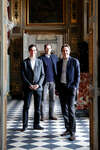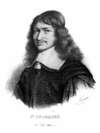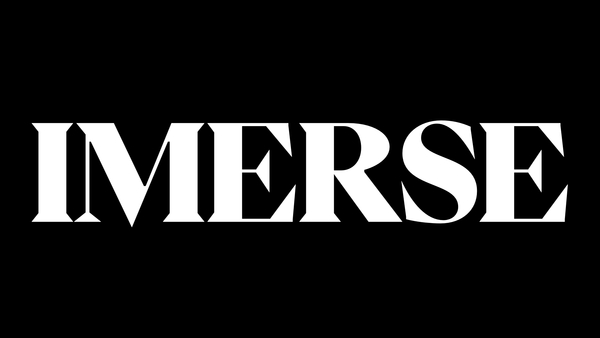The Château de Vaux-le-Vicomte Continues Writing Its History through Virtual Encounters with the French Grand Siècle

The most beautiful and luxurious private residence in France, the Château de Vaux-le-Vicomte, constructed for Nicolas Fouquet in the seventeenth century, is reinventing itself to better highlight what a masterpiece it is. Virtual reality, which offers new possibilities for artistic creation, has been used by the Vogüé family as a marketing tool to recount the history of the château in a spectacular manner. They have created immersive experiences inspired by the daring of the men and women who made Vaux and contributed to the greatness of France during the Grand Siècle and the tradition of the French art de vivre.
Christian Razel of Imerse conducts an exclusive interview with Alexandre de Vogüé, co-owner with his two brothers, Jean-Charles and Ascanio, of the Château de Vaux-le-Vicomte.

Alexandre de Vogüé (at the forefront), co-owner with his two brothers,
Jean-Charles and Ascanio, of the Château de Vaux-le-Vicomte
Christian Razel: What is unique about the Château de Vaux-le-Vicomte?
Alexandre de Vogüé: The château is a masterpiece of the seventeenth century that was constructed at the beginning of one of the richest periods of French history: the Grand Siècle.
The harmony between the garden and the buildings, the proportional precision, and the human scale of everything make Vaux-le-Vicomte one of the most beautiful family residences in the world.
This estate had a real influence on the artistic taste of His Majesty. Fouquet’s Vaux was a precursor of Louis XIV’s Versailles. This palace of the arts is, in a way, the “preface” to the Château of Versailles. The three most renowned artists of the time—the painter-decorator Charles Le Brun, the architect Louis Le Vau, and the landscape gardener André Le Nôtre—were brought together by Fouquet and subsequently engaged by Louis XIV to construct the Château of Versailles.
Vaux represented an architectural and landscaping achievement that was an inspiration for all of Europe for over a century.



How did your family come to own the property?
In the mid-nineteenth century, the château and its vast estate were abandoned by the previous owners. Everything was supposed to be divided up into lots and sold to developers. In July 1875, Alfred Sommier purchased the property. This rich French industrialist was our great-great-grandfather. He made his fortune in the sugar industry.
Alfred Sommier dedicated the rest of his life and part of his fortune to reviving the place, first by restoring the château and its roof. He wanted his family to be able to live on the estate during the summer months. His son Edme continued what his father had begun, notably by undertaking colossal restoration work in the gardens designed by André le Nôtre.
In half a century, thanks to the Sommier family, Vaux-le-Vicomte was returned to its former splendor and luxury. In 1968, Patrice de Vogüé, the grandnephew of Edme Sommier, decided to open the estate to the public in order to secure the income necessary to maintain what had become the most significant private property classed as a historical monument in France: 500 hectares enclosed by a 13km-long wall, 33 hectares of French-style garden, 270,000 feet of boxwood hedging, 2.5 hectares of roofing, about 100 rooms, and around 500 windows.
What business model does your family business use?
Our primary goal is to preserve this masterpiece, share it, and pass it on to the next generation in the best possible condition.
Family business: In 1968, Patrice de Vogüé established the family business. He and his wife were among the first families in France to welcome visitors from all over the world into their luxurious home. They offered all of the services that now seem essential for any establishment open to the public. Nevertheless, a gift shop like the one at Vaux was a rarity in the 1980s, as was a restaurant on the grounds.
In 1983, they founded the Amis de Vaux-le-Vicomte, an officially recognized non-profit. Thanks to the generosity of its members (2,700, making it the largest association connected to a private historic building in France), it can dedicate part of its budget to restoration, the enhancement of its art collection, and cultural outreach.
In 2011, our father retired, entrusting the management of the association to two of his sons, with the third becoming involved in 2015. Today, Ascanio, Jean-Charles, and I oversee the management of this heritage family business, which employs 65 people, welcomes 300,000 visitors per year, and balances its accounts with an operating budget of €8 million.
The challenge for the next generation will be to generate its own resources.
A new strategy was put in place in the face of competition from the châteaux in the Loire Valley, public châteaux such as Versailles and Fontainebleau, theme parks and zoos, and shopping malls, as well as the reduction in government subsidies granted to cultural sites open to the public.
Our entrepreneurial vision has become more professional.
Master plan: An investment master plan was created in 2017 by Méthodes et Pilotage.
Our long-term ambition (five years) is to double annual maintenance and restoration expenditure, to reach a total of €3 million, in order to maintain the estate. We have to deal with more regulatory requirements, technological developments, and an increase in the number of visitors. Our investment program includes the protection and restoration of the hydraulic system, the pipes, the art collection, the roof, the foundations … and security on the estate.
Annual resources of about €8 million are made up of €4 million from ticket sales, €2.4 million from restoration and the gift shop, and between €600,000 and €1.5 million from events. Private sponsorship is worth €1 million, of which €250,000 comes from our Association des Amis each year. State subsidies are only worth €250,000 per year.
Objectives: Our main source of income is visitors. Our objective is to go from 300,000 to 450,000 visitors over the next five years, with an average ticket price of €13. This increase in numbers will not come at the cost of the visitors’ experience, which must remain an enjoyable, comfortable, and immersive experience. The flow of visitors will need to be managed in such a way that the spirit of the place endures: that is, a château with a human touch that has always been inhabited and preserved by a family since it was built in 1661.
Considering the high number of French visitors (75%), international visitors represent our most significant potential for growth.
How are you going to increase visitor numbers at the estate?
We are going to create new, high-quality immersive experiences. Technology should allow us to democratize culture, recount the history of the château in new ways, and attract younger generations.
– The Immersive sound trail: On May 7, 2019, we launched an immersive 3D sound journey to impart the story of Nicolas Fouquet.
Actors, some of them from the Comédie Française, binaurally recorded scenes of the great party of August 17, 1661, organized by Nicolas Fouquet in honor of his king. The scenes play automatically when the visitor, equipped with a headset, enters a room in the château. The experience allows visitors to relive the best moments of this magnificent soirée, described by Voltaire as follows: “August 17, at 6 o’clock in the evening, Fouquet was the king of France; by 2 o’clock in the morning, he was no longer anything.” One thousand three hundred high-definition headsets were designed in association with our partner Focal. This technology was developed by a start-up called Narrative. This experience represents an investment of €750,000.
– The enchanted walk: A route through the woods and gardens is planned for 2020. Innovative technologies will be used at various points along the route to immerse visitors in the universe of the Grand Siècle. Visitors will be transported to another world of music, theatre, La Fontaine’s fables, and light.
– Video mapping: A six-minute projection will recreate large-scale images based on Charles Le Brun’s preparatory drawings for the Palais du Soleil. What would have been the largest painted fresco in seventeenth-century France was never completed because of Nicolas Fouquet’s arrest. This spectacle will be projected onto the ceiling of the cupola in the Grand Salon, where it was initially supposed to have been painted.


Plan for Charles Le Brun’s fresco, Le Palais du Soleil

Mapping video of Le Palais du Soleil
What new project do you want to finance through sponsorship?
Sponsorship has been at the heart of our business model since 2010. Private cultural institutions can offer a tax deduction to their generous donors.
The project being financed at the moment is an artwork called Rubans éphémères (Ephemeral Ribbons) by the French artist Patrick Hourcade. Situated in the gardens at Vaux-le-Vicomte, this new creation is in the form of an arabesque in line with the tradition established by André Le Nôtre. For between two to five years, it will replace the boxwood hedging in the two beds facing the château on the garden side. Last winter, 180,000 feet of aged and diseased boxwood had to be removed.
Rubans éphémères (Ephemeral Ribbons) is made up of 400 sloping sheets of aluminum. The sky is reflected in the sheets. The unveiling is scheduled for June 29. Between now and then, individuals and businesses can become owners of part of the work by adopting one of the sheets, signed by the artist.
Link to make a donation, “Adopt part of Rubans éphémères at Vaux-le-Vicomte”:
https://mecenatmh.fr/campaigns/plaquez-tout-pour-vaux-le-vicomte/

Tell us about the conference on the Fouquet years organized by your family?
On the occasion of the 400th anniversary of Fouquet, us three brothers organized a lecture series on Fouquet the builder, the patron, the art love, in association with La Monnaie de Paris (Paris Mint). This also served as an opportunity to name a scientific committee (Pierre Rosenberg, Bénédicte and Alexandre Gady, Daniel Dessert, Mathieu da Vinha, etc.) with which we regularly consult in relation to significant restoration work. Private châteaux are too often treated with condescension by the French intelligentsia associated with the museums. It was time to prove ourselves by insisting on the scientific approach we take to every project.
Archival documents convey the atmosphere surrounding money, power, and society at the time of the Grand Siècle. They show how the management of royal finances influenced governmental practices aimed at developing French art. Fouquet, who called upon the best artists of the time, was one of the most powerful patrons in France and discovered many extraordinarily talented artists. He shared the same passions as the king.

Nicolas Fouquet
What is your favorite artwork at Vaux-le-Vicomte?
This year, the Association des Amis du Château de Vaux-le-Vicomte acquired Le Silence à l’écureuil (Silence with a Squirrel). This seventeenth-century work of gouache on vellum is attributed to François Chauveau (1613–1676) and is based on Silence, a 1655 oil-on-canvas painting by Charles Le Brun, first painter to the king.
This little painting would have belonged to Nicolas Fouquet.
Charles Le Brun (1619–1690) painted Silence, in which Saint John the Baptist carries a squirrel in his arms. This painting, now in the Louvre, would have been offered to the king by a financier who had taken the precaution of removing the Fouquet coat of arms.
According to an inventory taken after his death, François Chauveau made a copy of the squirrel.
It’s a symbol that we have placed in Nicolas Fouquet’s bedroom, on the second floor of the château.



